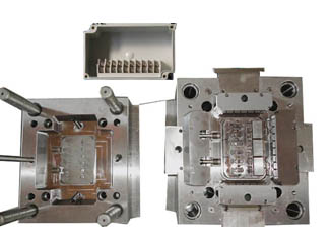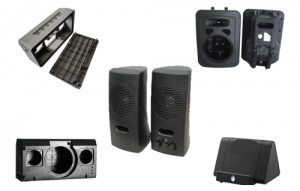Electrical junction box and molding
Short Description:
Electrical junction boxes are widely used for transmission and distribution of power and communication. The main parts of the junction box shell and cover are mostly plastic produced by injection molding.
Electrical junction boxes are widely used for transmission and distribution of power and communication. The main parts of the junction box shell and cover are mostly plastic produced by injection molding. The junction box needs to comply strict electrical performance standard, so we will introduce the electrical junction box and molding here.
What is plastic junction box ?
Electrical junction box is also called connecting box, terminal box, electrical connector, terminal base.
An electrical junction box is an enclosure housing electrical connections, to protect the connections and provide a safety barrier.
A small metal or plastic junction box may form part of an electrical conduit or thermoplastic-sheathed cable (TPS) wiring system in a building.
If designed for surface mounting, it is used mostly in ceilings, under floors or concealed behind an access panel - particularly in domestic or commercial buildings. An appropriate type (such as that shown on the left) may be buried in the plaster of a wall (although full concealment is no longer allowed by modern codes and standards) or cast into concrete - with only the cover visible.
Plastic electrical boxes have their pluses and minuses. Because they are plastic, there is no need to attach a ground wire to it. Since it is made of a non-conductive material, switches and outlets cannot short out if they touch the side of the box.
Plastic boxes usually come with tapped screw holes for easy attachment of switches and outlets. These boxes come in a single-gang, double-gang, and even multiple-gang configurations.
Types of electrical junction box
Electrical junction boxes types are various: indoor type , outdoor type, high voltage resistance type, and waterproof type. Materials and safety requirements vary from different environments and countries. Therefore the injection mold and forming processing are also different.
1. indoor electrical junction box.
Resin types: ABS, PVC
Most of these are office and home wiring boxes. They are used for indoor power distribution and centralized control, as well as on-off power supply, and communication line access and control. The general working voltage is below 250 volts. The plastic resin is required to comply with the flame retardant grade UL94 V1~V0 .
2. outdoor electrical junction box.
Resin types: ABS,ABS/PC
Outdoor junction box is required to be able to withstand the outdoor high and low temperature and rain moisture and sunlight aging corrosion, product structure waterproof, anti-ultraviolet radiation aging, adapt to high and low temperature environment. It is necessary to use high quality plastics, such as PC or nylon, with special additives with excellent ultraviolet resistance and high and low temperature performance.
3. Industrial junction box.
Resin types: ABS, ABS/PC, Nylon
Industrial junction box, often have a special performance requirements, such as dimensional accuracy and stability, oil and alkali resistance, wear resistance. Plastic materials should be selected for different requirements and mold accuracy should be determined.
4. high voltage resistance electrical junction box.
Resin types: ABS, ABS/PC, Nylon
The junction box is mainly used for high voltage environment, such as electrical cabinets, electrical control boxes, distribution devices. Good insulation and anti-aging properties are required. Nylon and other engineering plastics are generally selected.
5. The main function of the photovoltaic module junction box is to connect and protect the solar photovoltaic module, conducting the current generated by the photovoltaic module. As an important component of solar cell module, the junction box of photovoltaic module is a comprehensive product which integrates electrical design, mechanical design and material application. It provides users with a combined connection scheme of solar photovoltaic module.
6. Waterproof junction box.
Resin types: ABS, ABS/PC, PPO
There are two standards for waterproofing.
A. Short external splash, i.e. water will not be poured directly on the product.
B. The product is immersed in water.
Waterproof requirements mainly depend on the structure of plastic parts, such as:
Encrypt the sealing ring at the joint or opening;
Ultrasound welding of two joints:
Integral injection molding.

Waterproof junction box

Outdoor plastic junction box

Indoor lighting junction box

Tee plastic junction box

Common use plastic junction box

Nylon plastic junction box
Requirements for the use of electrical junction boxes
Electrical junction boxes are closely related to electricity and must comply with the relevant safety standard or requirements, mainly:
1. Weather resistance: resistance to high and low temperatures, humidity
2. Electrical Insulation
3. Resistance to high voltage, dielectric constant and dielectric loss: Can work in high voltage or low, medium and high frequency electric field.
4. Heat dissipation: the heat generated by the internal parts can be emitted more quickly.
5. Flame retardant: It is not easy to ignite and cause fire.
6. Anti-ultraviolet radiation: When the electrical junction box is in a strong light or outdoor environment, it will not be aging and failure due to ultraviolet radiation.
7. Corrosion resistance: In acid, alkali and salt environment, it will not corrode and damage, and can work for a long time.
8. Sealing and waterproof: able to work in wet or water environment
9. Environmental protection: Ensure that the materials used will release toxic substances or smoke when heated or burned, which will harm human health.
Design Considerations of Electrical Connection Box
1. Material selection: At present, the main application fields of waterproof junction box products are relatively harsh construction site and open-air site. The impact resistance, static load strength, insulation property, * non-toxicity,* aging resistance, corrosion resistance and flame retardancy of materials should be considered when considering the safety performance of products. (Non-toxic performance has been widely concerned, mainly because if the waterproof junction box products in the case of fire, combustion will not release toxic and harmful gases, usually in the event of fire due to inhalation of a large number of toxic gases and death accounted for the majority.
2. Structural design: Consideration should be given to the overall strength, beauty, easy processing, easy installation and recycling of waterproof junction boxes. At present, the waterproof junction box products produced by the main international manufacturers do not contain any metal parts, which can simplify the product recovery process. However, the materials used by most domestic manufacturers are different, and the anti-waxy properties of the materials are poor. Generally, brass inserts are installed in the installation socket of the waterproof junction box to increase the installation strength, which will increase the time and cost for the material recovery process. Such problems can be solved by choosing raw materials with high performance indicators provided by regular manufacturers.
3. Wall Thickness: Generally, when considering the overall cost of the product, the product wall thickness should be reduced as much as possible to meet the impact resistance and waxy resistance of the product. In the design of international waterproof junction boxes, the wall thickness of ABS and PC materials is generally between 2.5 and 3.5 mm, glass fiber reinforced polyester is generally between 5 and 6.5 mm, and the wall thickness of die-cast aluminum materials is generally between 5 and 6.5 mm. It's between 2.5 and 6. Material wall thickness should be designed to meet the installation requirements of most components and accessories.
4. Sealing ring material selection: For waterproof junction box products, commonly used sealing ring materials are: PUR, EPDM, Neoprene, Silicon. The temperature range, tension resistance, expansion ratio, hardness, density, compression ratio and chemical resistance should be taken into account when choosing sealant ring.
5. Fixed waterproof connection cover screw material: When the waterproof junction box cover and the base are combined, the key component is the bolt. The selection of bolt material is also very critical. The commonly used material is PA (nylon) or PA alloy, and stainless steel tapping screw can also be used. Structural strength should be considered in the design of top screw. Because different users use different ways and meet various requirements, such as installation of electric screwdriver and manual installation, the torque force of screw should be considered in the design.
Electrical junction box mold and molding
The main parts of junction box is plastic housing and cover. They are created by the method of plastic injection. The tool is injection mold.
The design of the junction box injection mold depends on the design structure and output of the junction box, which determines the structure design of the mold and cavity layout.
The steel and hardness of the mold inserts depend on the plastic resin charactor,the surface texture of the product and the target life of the moldd. Steel P20 is often used as the mold insert material for usual orders, and S136 is also used for high gloss surface. For large orders of products , multi cavities mold is needed to increase production capacity.

Junction box plastic injection mold
Mestech has accumulated rich experience for making mold and injection production for junction boxes for many customers. If you have the demand for plastic parts in the junction box, please contact us.














